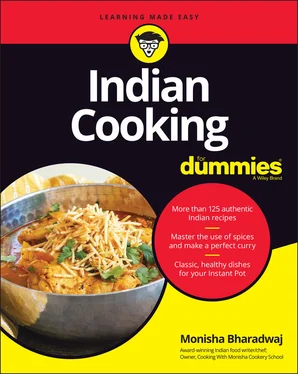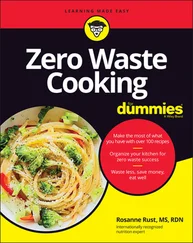I’ve heard people in my cooking classes say they’re nervous about going into an Indian grocery store because of the unfamiliar ingredients and produce. They’re probably seeing many vegetables never found on the Western table, with names that mean nothing to someone who doesn’t speak fluent Hindi. In this section, I take the mystery out of some of those fresh ingredients.
Aromatics and herbs: Veggies with a punch
Fresh aromatics and herbs are as important as spices. Here’s what to look for when choosing them and how best to store them:
Fresh chilies: You’ll want to use the same variety of chile every time, so you know how hot it is whenever you use it and not have to play chile roulette. I prefer the bird’s eye or thin green chilies. The smaller the chile, the hotter it is, so these are pretty powerful. You can control the heat by the way you chop them (see Chapter 6). Most recipes ask for fresh green chilies, although you can use red ones as well. Red chilies are just green chilies that have ripened, so they have a shorter shelf life. You can freeze fresh chilies, but use them from frozen because they go limp when defrosted.
Cilantro and mint: An Indian store will have big, fresh bunches tied together as opposed to a few stalks you see wrapped in plastic bags in bigger supermarkets. To store, line a large, airtight plastic box with paper towel and place the herbs in. Store in the fridge for a couple of weeks, replacing the paper towel every few days.
Curry leaves: You’ll find the freshest ones in the Indian market. The stalks are sold in small plastic bags. It’s easy to dry them at home, and they taste much better than the dried ones you can buy commercially. Just take them off the stalks and dry them on a tray on your kitchen counter for three to four days. Put the dehydrated leaves into an airtight box in the fridge up to two months. If you can’t find fresh curry leaves, the store-bought dried ones will do.
Fenugreek: Fenugreek leaves are available as a fresh bunch and are used in vegetable dishes the way spinach is used. They’re also dried to use as a herb called kasuri methi, which is available in packs and will last up to a year if stored in a cool, dark place. Fenugreek is the essential flavor in dishes such as Murgh Makhani (Butter Chicken; see Chapter 11). Fenugreek seeds are the spice and can’t be used in place of kasuri methi.
Garlic: Much of what you see in the produce aisles is Chinese garlic. You can tell by the fact that it’s sold rootless, which reduces shipping weight and costs. Garlic grown domestically mostly has roots. You can use either type. Choose fat bulbs that don’t collapse when you press them and look for mold around the root end, which is a sign that they’re going bad. Store garlic in your onion basket or in the fridge.
Ginger: Most of the ginger you see in your grocery store probably comes from China, but you may also find organic ginger from Peru. Look for firm, shiny-skinned ginger with as little discoloration as possible. A crinkly skin means that it’s getting a bit old and dehydrated, so the flesh will most likely be very stringy.The best thing you can do with ginger and garlic is make your own paste, a lovely homemade ingredient that will speed up your Indian cooking. (You can find out how to make and store your own ginger-garlic paste in Chapter 6.)If you want to leave some ginger whole, store it wrapped in paper in the fridge or freezer and grate from frozen into curries.
Eggplants are enjoyed in every regional cuisine of India. This shiny purple vegetable can be prepared in so many ways — combined with spices, yogurt, onions, or tomatoes, or thrown into curries to make them meatier and delicious. You’ve probably seen a variety of eggplants. Table 4-6explains how to pick the right one.
TABLE 4-6Buying Eggplant
| Variety |
Description |
| Globe, American, or Dutch |
These varieties are large with dark-purple skin. They’re good in many Indian recipes, such as curries, and for fire roasting (see Chapter 13) to mash with spices. Because they’re fat and meaty, they slice well for fritters, too. |
| Graffiti |
Graffiti eggplant is pretty to look at, with purple and white stripes. They’re as versatile as the globe eggplant. The stripes aren’t retained during cooking, and they have fewer seeds than the globe eggplant. |
| Indian or Kenyan |
These varieties are smaller and rounder, so they taste delicious stuffed. Slit it into quarters, leaving the stalk on, so you can fill with your favorite spice masala and cook whole. They can have lots of seeds, so if you’re looking for a smoother texture, choose the Chinese eggplant. |
| Chinese or Japanese |
Long and thin, they’re meaty enough to be diced up for curries and can be stuffed. |
| White |
There’s no difference in taste. They just look very pretty. |
Although potatoes were introduced to India relatively recently, in the early 17th century (remember that India’s culinary history goes back thousands of years), they’re a much-loved ingredient in the Indian kitchen. Potatoes are added to curries to make them go further, cooked with spices to be eaten with Indian breads, battered and fried as snacks, and mashed to make spiced cakes.
I often get asked whether to use waxy or floury/starchy potatoes in curries. The good news is that it’s not always that important. Potatoes don’t need to hold their shape in all curries and some actually taste better when the potatoes crumble and add thickness to the sauce.
Floury: These are high in starch and have less moisture than the other kinds, which causes them to lose their shape easily. Stirring them constantly while cooking breaks them up and releases the starch, resulting in a gloopy curry. This is fine in some dishes that have potato as a main ingredient, such as the breakfast Batata Bhaji (Spiced Yellow Potatoes; see Chapter 17). They’re best used in recipes that need mashed potatoes such as Vegetable Samosas (Vegetable and Pastry Parcels; see Chapter 18). Examples of starchy potatoes include russet and red potatoes.
Waxy: On the opposite end of the spectrum are potatoes with a higher moisture content and lower starch content. These potatoes hold their shape better when cooked, and they taste buttery. They’re great in curries where they share the stage with other ingredients such as Aloo Gobi (North Indian Potatoes with Cauliflower; see Chapter 13) and for boiling. Varieties include new or baby potatoes and red fingerlings.
All-rounders: These fall somewhere in between the other two in terms of their starch and moisture content. They do all jobs well, so if you don’t want to buy a variety of potatoes, a bag of all-purpose white or yellow potatoes will be perfect for all your Indian recipes. Some cooks deliberately crush a few of the potatoes after they’re cooked to add to curry sauce to thicken it up.
The concept of eating seasonally is still very popular in India. Farmers markets in the winter are filled with dark orange carrots and gleaming white cauliflowers. But it’s the summer markets that excite me the most. Every year, around April (start of the summer in India), all of a sudden you see stalls filled with mangoes start to pop up in these markets. These aren’t just any mangoes either — they’re the most fragrant, sweetest, firmly fleshed mangoes in the world. The mighty Alphonso mango is arguably India’s best loved variety, and shoppers are willing to pay any price for those first few boxes. The price never really comes down because the season is short and demand is high. It’s no wonder that the mango is the national fruit of India. Alphonso mangoes are grown in a small region of India in the western state of Maharashtra. Other mangoes, such as the not nearly as good Kesar mango from Gujarat, start to appear a few weeks later.
Читать дальше












